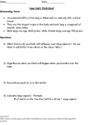Lung Limit
| Instant wiki maker | Making handouts | Editing tips |
Contents
- 1 Lung limit
- 1.1 Student worthiness
- 1.2 Primary biological content area covered
- 1.3 Materials
- 1.4 Handouts
- 1.5 Description of activity
- 1.6 Lesson plan
- 1.7 Pitfalls and experiences with experiment
- 1.8 Math connections
- 1.9 Literature connections
- 1.10 Connections to educational standards
- 1.11 Next steps
- 1.12 Citations and links
Biology In Elementary Schools is a Saint Michael's College student project from a course that ran between 2007 and 2010 and fully described in this book chapter. The student-created resources have been preserved here for posterity. Link under 'toolbox' for printer-friendly versions of the exercises. Click on handouts to print full resolution versions. Please see Wikieducator's disclaimer, our safety statement, and the Creative Commons licensing in English and in legalese.
Lung limit
Student worthiness
Tried and Trusted
Primary biological content area covered
Lung capacity; human body; displacing volume of water with volume of air; spirometer use
Materials
- 2 liter plastic bottle
- Large deep bowl or plastic dishpan
- Water
- Masking tape
- Measuring cup
- 1 foot long piece of flexible tubing
- Pen/pencil
- Paper
- Short cardboard tubes
Handouts
Description of activity
Using simple math, students will figure out their lung capacity by breathing into a bottle filled with water and measuring the volume of water displaced.
Lesson plan
- Discuss the purpose of the lungs in the human body and hypothesize with students what they think will happen.
- Prevent the spreading of germs from the mouth by using masking tape, disposable straws, or short cardboard disposable tubes.
- Take a deep breath and exhale completely into the tube.
- Have a partner record how much air is now in the bottle by using the marks on the bottle to measure.
- Calculate your lung capacity by multiplying the number of marks filled with air by 60 mL.
Pitfalls and experiences with experiment
One potential pitfall is the possibility of germs being spread. We will be using different cardboard tubing for each student; however, if this is not available there may be some discrepancies. The tape may not be strong enough to hold the tube to the bottle. Students may therefore have mathematical errors (individual).
Also, students might not be able to accurately measure the water displaced by the air in the bottle. If this is the case, their answers may vary.
- The time was not budgeted well for each group and the activity could not be completed with six students in twenty minutes, but we worked around it and figured out ways to make it longer or to cut it off early.
- We used the word 'hypothesis' thinking that they knew what it meant but found out that they did not, so they were able to expand their scientific vocabulary during the program.
- Having a pair of freeze-dried sheep lungs there as a visual was a definite plus. However originally telling the kids that it was a human lung and being mistaken was a little embarrassing
- We had not planned on each of the adult educators also doing the experiment, but they did and it worked out extremely well; the kids really enjoyed comparing our "scores".
- The third graders were quite competitive in completing this activity and took great pride in their lung capacities as they were added to the scatter plot. This made the activity even more fun than anticipated.
- I found that encorporating the literature by reading them the "Magic School Bus" book was a plus because it allowed us to take up more time with the kids while teaching them more.
Math connections
Multiplication and forms of measurement. Student lung capacities can be displayed in a bar graph. You could average scores based on gender or graph individual scores. We made a scatter plot with the lung capacity shown on the y-axis and however you choose to categorize students (i.e. gender, each student, etc.) can go on the x-axis. This will help students think comparatively.
Literature connections
Scholastic's The Magic School Bus: Inside the Human Body, by Joanna Cole & Bruce Degen is a great way for students to understand what goes on inside the human body in a fun and exciting adventure!
Connections to educational standards
S:2 Students demonstrate their understanding of predicting and hypothesizing. (7.1 b ) Enduring Knowledge (Predicting and Hypothesizing): Scientists’ explanations about what happens in the world come partly from what they observe and partly from what they think. Preliminary explanations are constructed with conceptual knowledge and propose a new level of understanding. At early stages, students think about what may happen during an investigation and justify their thinking. At later stages, students identify cause and effect relationships within an hypothesis and base predictions on factual evidence more than opinion.
S:4 Students demonstrate their ability to conduct experiments (7.1 c; 7.2 c, d; 2.2 e, f, g )Enduring Knowledge (Representing Data and Analysis): Students represent data using text, charts, tables, graphs.
Next steps
In learning about lung capacity, students can compare their results to adult lung capacities or other mammals. Does size or age make a difference for your lungs? This activity opens the door to many questions and expansions, which can be further explored.
Citations and links
Vermont State Grade Expectations can be found at the State of Vermont Department of Education website. [1]


